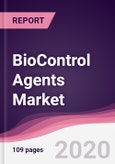What are the Biocontrol Agents?
Biocontrol agents are the natural organisms like parasitism, predation, and other mechanisms for controlling the plant pests. They play a key role in controlling the plant pests such as nematodes, weeds, mites. These biocontrol agents help in maintaining and balancing the plant species like nematodes weeds, insects, and mites. Biocontrol agents have no side effects as they are eco- friendly in nature.
Due to the lucrative aspects, Biocontrol agents are replacing the pesticides and other chemicals. Factors such as ease of use and its availability are driving the biocontrol agents market. Biocontrol agents are effective throughout the season and are considered economical as compared to other chemicals such as pesticides and insecticides, thus the growth of biocontrol agents will certainly expand in the coming future. Increasing investments by key market players in biological solutions especially in R&D capabilities is creating opportunities for the biocontrol agents market. However, lack of awareness and knowledge among growers regarding biocontrol agents are hindering the growth of the market. This report incorporates an in-depth assessment of biocontrol agents market by active substance, application, environment, crop type, target pest, and geography. The major types of biocontrol agents encompassed in the scope includes various active substances such as microbial.
What are the major applications for Biocontrol Agents?
The various applications include on-field, seed treatment, post-harvest. Among these applications of biocontrol agents, the on-field application is growing at a faster rate. On-field sprays protect the field’s crop, vegetables and food products that are cultivated from various pests and insects that may damage the product. On-field spraying is considered safe to use and thus most of the farmers are using this technique for better production.
Market Research and Market Trends of Biocontrol Agents Ecosystem
Increasing concentration on food contamination owing to a variety of chemicals is fueling the market growth of biocontrol agents
Rising demand of biocontrol agents compared to pesticides owing to their cost effectiveness are boosting the growth and development of the biocontrol agents market. Biocontrol agents are capable of replacing chemical agents that are used by decreasing emissions in the environment and thus resulting in lesser soil and water pollution hence the demand for biocontrol agents is rising day-by-day
Acceptance regarding biological control agents in the agricultural system, increasing use of biocontrol agents for pest control in horticulture and high value crop fields spurs the biocontrol agent market for these products
On-field (Spray) are estimated to dominate the biocontrol agents market with a share of around 58%, thus generating excess revenue of $1.22 billion in 2020. The market is forecast to witness a growth of nearly 10.39% projecting to around $3.71billion by2025 , which is mainly attributed to the growing demand from the applications such as seed treatment, post-harvest and so on
North America region has dominated the biocontrol agents market in 2020 and is estimated to grow with a CAGR of 10% during the forecast period 2020-2025
Vegetables & fruits are the major crop types which are holding a share of 46% of biocontrol agents market in 2020. As per recent analysis, the biocontrol agents market is forecast to surpass $3.71billion by 2025 majorly driven by microbials
Who are the Major Players in Biocontrol Agents market?
The companies referred to in the market research report includes Bayer CropScience AG, BASF SE (Germany), Syngenta AG (Switzerland), Novozymes A/S (Denmark) and Koppert Biological systems (the Netherlands)
What is our report scope?
The report incorporates in-depth assessment of the competitive landscape, product market sizing, product benchmarking, market trends, product developments, financial analysis, strategic analysis and so on to gauge the impact forces and potential opportunities of the market. Apart from this the report also includes a study of major developments in the market such as product launches, agreements, acquisitions, collaborations, mergers and so on to comprehend the prevailing market dynamics at present and its impact during the forecast period 2020-2025.
Key Takeaways from this Report
- Evaluate market potential through analyzing growth rates (CAGR %), Volume (Units) and Value ($M) data given at country level – for active substamce, applications and by different crops.
- Understand the different dynamics influencing the market – key driving factors, challenges and hidden opportunities.
- Get in-depth insights on your competitor performance – market shares, strategies, financial benchmarking, product benchmarking, SWOT and more.
- Analyze the sales and distribution channels across key geographies to improve top-line revenues.
- Understand the industry supply chain with a deep-dive on the value augmentation at each step, in order to optimize value and bring efficiencies in your processes.
- Get a quick outlook on the market entropy – M&As, deals, partnerships, product launches of all key players for the past 4 years.
-Evaluate the supply-demand gaps, import-export statistics and regulatory landscape for more than top 20 countries globally for the market.
Table of Contents
Methodology

LOADING...








